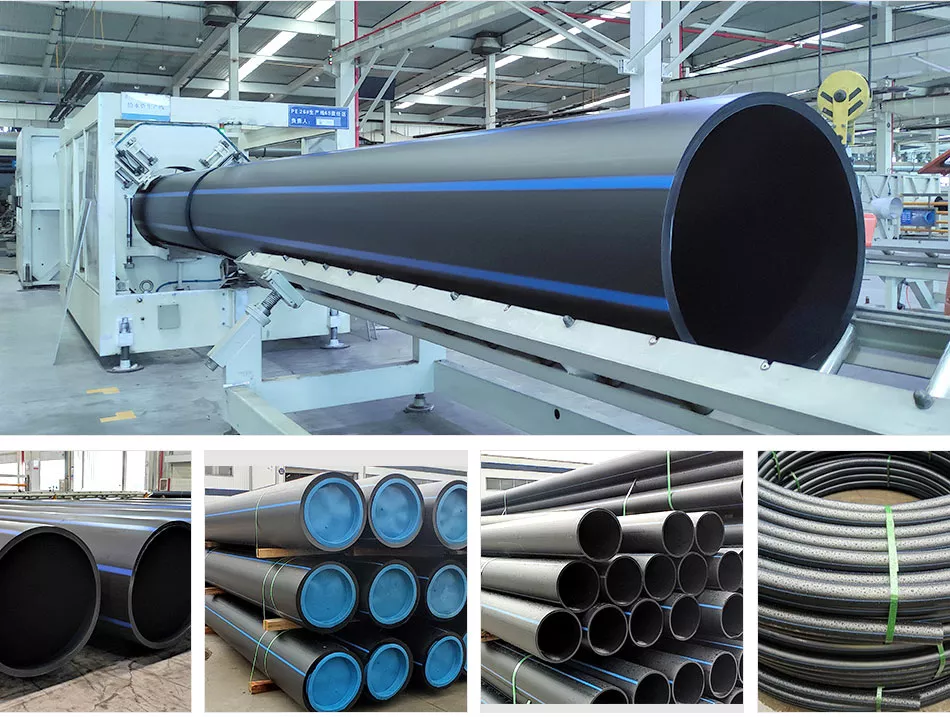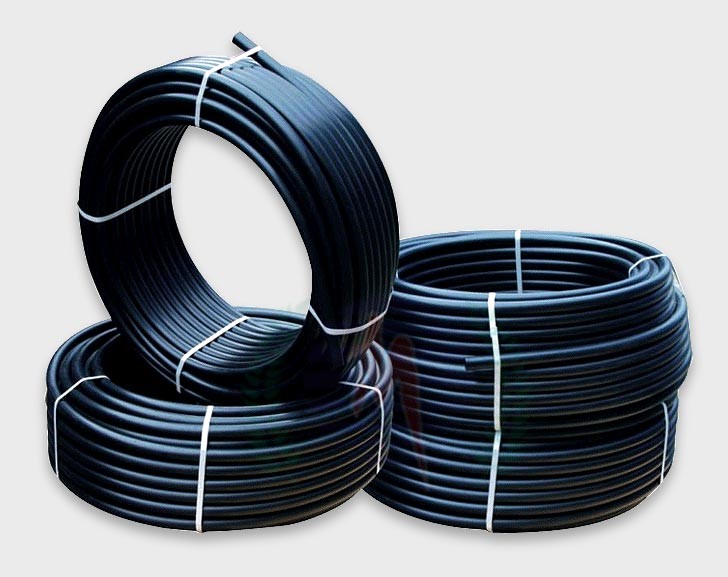How hdpe pipe suppliers Midland TX Are Transforming Oil and Gas
Wiki Article
Explore the Manufacturing Refine Behind High-Quality HDPE Pipe and Its Applications
The production process of high-quality HDPE pipelines is complex and methodical. It begins with the choice of raw materials that improve efficiency. Following this, ethylene goes through polymerization to develop material, which is after that shaped with extrusion. Quality control is paramount, guaranteeing that the end product fulfills strict standards. The journey of HDPE pipes does not finish with production. Their applications across different industries disclose a broader relevance worth analyzing.Understanding HDPE: Qualities and Advantages

High-density polyethylene (HDPE) is a flexible thermoplastic known for its durability and resistance to numerous ecological variables. This material shows exceptional tensile toughness, making it ideal for demanding applications. Its low-density framework adds to a light-weight product, helping with convenience of taking care of and installation. HDPE also showcases impressive resistance to chemicals, which lessens degradation when subjected to harsh materials.
The product's low wetness absorption better enhances its durability, making it ideal for usage in pipelines and tank. Furthermore, HDPE is resistant to ultraviolet (UV) radiation, making certain that products preserve their honesty also when revealed to sunlight. Its flexibility permits for the development of detailed shapes without jeopardizing stamina. The environment-friendly nature of HDPE, often stemmed from recycled products, contributes to its allure, advertising sustainable practices in manufacturing. On the whole, these properties and advantages make HDPE a preferred option for different commercial and consumer applications.
Raw Material Selection for HDPE Production
The selection of resources for HDPE production is necessary to verify the end product meets the desired specifications and quality requirements. High-density polyethylene (HDPE) is largely generated from polymerized ethylene, originated from nonrenewable fuel sources such as gas or petroleum. The quality of these feedstocks significantly influences the mechanical and thermal residential properties of the final HDPE.Additives also play a substantial function in improving HDPE's performance, including antioxidants, UV stabilizers, and colorants, which boost resilience and resistance to environmental factors. The selection procedure must think about not just the chemical structure of the raw materials yet also their processing features to ensure efficient production.
The sourcing of raw products ought to focus on sustainability and compliance with environmental regulations, as liable methods are important in today's market. Ultimately, careful resources option lays the foundation for creating top notch HDPE pipes appropriate for varied applications.
The Extrusion Refine: Forming HDPE Pipeline
The extrusion process plays a vital function in forming HDPE pipes, starting with thorough product prep work strategies that guarantee suitable flow and consistency. Similarly vital is the design of the die, which directly affects the final dimensions and surface area top quality of the pipe. Together, these aspects contribute significantly to the effectiveness and quality of HDPE pipe manufacturing.Material Prep Work Strategies
Efficient manufacturing of HDPE pipes begins with precise material prep work techniques, especially the extrusion process. During this stage, high-density polyethylene material is first dried to eliminate moisture, making certain ideal flow qualities. The resin is then fed into the extruder, where it undergoes heating and melting, transforming right into a thick state. This heating process is very carefully controlled to maintain the material's integrity and efficiency. The liquified HDPE is forced with a die, shaping it into a continuous pipe type. Appropriate temperature management throughout extrusion is important, as it directly impacts the material's buildings and the final product top quality. When shaped, the HDPE pipe is cooled down and cut to specified lengths, all set for subsequent handling and applications.Die Layout Relevance
Accuracy in die design plays an important duty in the extrusion procedure of HDPE pipes. The die works as the last shaping tool, directly affecting the pipe's measurements, wall thickness, and surface finish. A properly designed die guarantees uniform product flow, reducing flaws such as irregularities and weak points. The geometry of the die have to be enhanced to accommodate the details buildings of HDPE, including its thickness and thermal behavior throughout extrusion. Furthermore, the cooling rate of the product as it passes through the die can considerably influence the pipeline's structural stability. Spending in advanced die innovation is important for manufacturers aiming to generate high-quality HDPE pipelines that meet market criteria and customer expectations.Top Quality Control Measures in HDPE Manufacturing
Although different variables affect the high quality of HDPE pipe manufacturing, reliable high quality control measures are critical to assure consistency and dependability in the final item. Trick high quality control methods include rigorous material assessment, verifying that the raw polyethylene meets established criteria for purity and density. Throughout the extrusion process, parameters such as temperature, pressure, and cooling time are very closely checked to keep dimensional accuracy and architectural honestyIn enhancement, post-production screening is vital; suppliers commonly conduct hydrostatic examinations to evaluate the pipeline's stamina and resistance to pressure. Aesthetic assessments for surface defects additionally enhance quality assurance. Certification from pertinent requirements organizations, like ASTM or ISO, supplies an additional layer of integrity. By implementing these complete quality control actions, makers can reduce issues, improve efficiency, and ensure that the HDPE pipelines meet the details requirements of different applications, eventually causing consumer complete satisfaction and trust fund in the product.
Applications of HDPE Pipeline Throughout Industries
HDPE pipelines are utilized across various markets due to their resilience and flexibility. In water circulation systems, they ensure effective delivery, while in wastewater administration, they give reliable remedies for waste transportation. In addition, farming irrigation networks benefit from HDPE's resistance to corrosion and versatility, making it an excellent option for contemporary farming techniques.
Water Circulation Equipments
A substantial variety of sectors count on high-density polyethylene (HDPE) pipelines for effective water circulation systems. Recognized for their durability and resistance to deterioration, HDPE pipes are widely made use of in local supply of water networks, agricultural watering, and industrial applications. Their lightweight nature helps with easy handling and installation, lowering labor expenses and time. Furthermore, HDPE pipelines can fit numerous pressure levels, making them appropriate for both low and high-pressure systems. Pipe Manufacturing Midland TX. The flexibility of the material enables for seamless assimilation into existing framework, lessening the requirement for extensive excavation. HDPE's resistance to chemical seeping guarantees that the water provided stays secure and clean, making it an ideal option for preserving the quality of safe and clean water across various sectors.Wastewater Monitoring Solutions
Efficient water circulation systems additionally pave the means for innovative wastewater administration solutions, where high-density polyethylene (HDPE) pipes play a substantial role. Distinguished for their durability and resistance to deterioration, HDPE pipes are optimal for moving wastewater in various settings. Their versatility permits very easy installment in intricate environments, reducing the requirement for considerable excavation. Additionally, HDPE's smooth indoor surface decreases friction, boosting circulation rates and performance. These pipelines are also resistant to chemical leaching, making certain that pollutants do not jeopardize the surrounding atmosphere. Industries, communities, and therapy centers progressively depend on HDPE pipes for their reliability and long life, making them a preferred choice for modern-day wastewater administration systems. This adaptability underscores the important relevance of HDPE pipes across numerous applications.Agricultural Irrigation Networks
Agricultural watering networks benefit significantly from using high-density polyethylene (HDPE) pipelines, which give effective and reputable water delivery to plants. HDPE pipelines are lightweight, plumber gas line repair making them easy to move and set up, while their flexibility enables different configurations in varied surfaces. These pipes demonstrate excellent resistance to deterioration, chemicals, and UV radiation, making sure longevity in harsh farming atmospheres. Additionally, their smooth indoor surface reduces friction loss, enhancing water circulation and minimizing power expenses connected with pumping. The durability of HDPE pipelines, usually going beyond half a century, contributes to reduce upkeep and replacement expenditures. Consequently, farmers increasingly depend on HDPE pipes to boost watering efficiency and advertise lasting farming methods, inevitably causing boosted crop yields and source conservation.Future Fads in HDPE Pipe Modern Technology
As the demand for lasting and efficient facilities grows, improvements in HDPE pipeline innovation are poised to transform different markets. Arising fads include the assimilation of clever innovations, such as sensing units and IoT capabilities, which facilitate real-time surveillance of pipeline problems, reducing maintenance prices and stopping leaks. Additionally, the advancement of advanced production strategies, such as 3D printing, is making it possible for the manufacturing of complex, customized pipe styles that deal with certain task demands.The emphasis on recycling and circular economy methods is driving the development of HDPE pipelines made from recycled materials, improving sustainability. Improved jointing methods, such as electro-fusion and mechanical fittings, are additionally boosting installation efficiency and reliability. The growing focus on environmental regulations is pressing suppliers to take on greener production procedures, making sure that HDPE pipes not only fulfill market standards yet also cultivate an even more sustainable future for framework advancement.
Regularly Asked Concerns
Exactly How Does HDPE Compare to Various Other Plastic Materials?
HDPE outshines numerous other plastic products concerning resilience, chemical resistance, and adaptability. Its low density and high tensile stamina make it ideal for different applications, typically going beyond options in both efficiency and longevity.What Are the Ecological Influences of HDPE Production?
The ecological effects of HDPE manufacturing consist of greenhouse gas emissions, power intake, and prospective air pollution from manufacturing processes. Furthermore, inappropriate disposal can bring about dirt and water contamination, elevating concerns about long-lasting environmental results.Can HDPE Piping Be Recycled?
Yes, HDPE pipelines can be reused. Many facilities accept utilized HDPE for handling, changing it right into brand-new items. This recycling contributes to sustainability initiatives, reducing plastic waste while conserving sources and power in the production cycle.What Is the Lifespan of HDPE Pipeline?

Just How Do Temperature Variations Affect HDPE Pipe Performance?
Temperature variants greatly impact HDPE pipe efficiency, influencing flexibility and strength. Heats can result in softening, while low temperature levels might create brittleness, inevitably affecting the pipe's durability and suitability for various applications in diverse settings.Report this wiki page